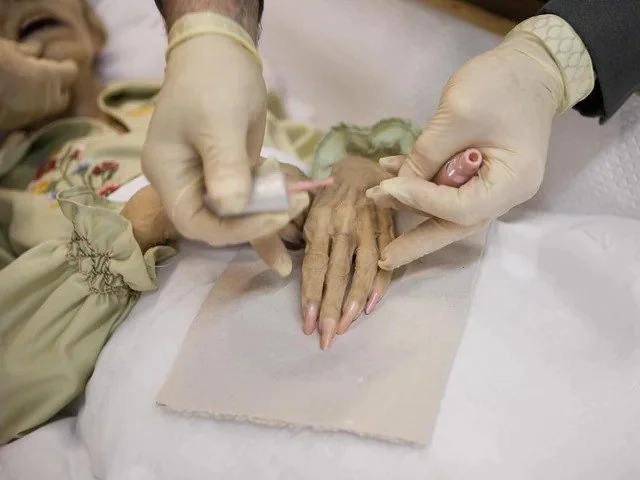How Long Does It Take to Prepare a Body for a Traditional Funeral?
In funeral homes around the world, preparing a body for burial is both technical and highly intimate. It is rooted in ritual, science, and care. While time frames vary, the full process usually takes between 2.5 to 4.5 hours, depending on the condition of the body, family preferences, and religious or cultural needs.
For horror writers, this behind-the-scenes process holds layers of narrative potential. There’s reverence, but also vulnerability. A body, after all, is never more still or more exposed than in these quiet final moments before viewing.
Step-by-Step Process
1. Initial Preparation (30–60 minutes)
Once the body arrives at the funeral home, identification is confirmed, and personal items like jewelry or clothing are cataloged. Then:
The body is washed with disinfectant.
Rigor mortis is relieved through massage to allow natural positioning.
Facial features are set:
Eyes are closed with plastic caps that help maintain shape.
The mouth is closed using sutures or small pins called needle injectors.
Cotton may be added in the cheeks or mouth to restore volume.
It’s a quiet, almost meditative phase. The goal is to begin restoring peace to the face and body.
2. Embalming (1–2 hours)
Embalming delays decomposition and restores a lifelike appearance for viewing. It involves two parts:
Arterial Embalming: A preservative solution is pumped through the vascular system, replacing the blood.
Cavity Embalming: A long instrument called a trocar is used to remove internal gases and fluids, then fill the cavities with a stronger preservative.
Bodies that have undergone trauma, decomposition, or organ donation may require specialized techniques or added reconstruction.
3. Cosmetic Application and Dressing (30–60 minutes)
After embalming:
The body is washed again.
Cosmetics are applied, foundation, lip tint, blush, and powder, to give the skin a natural glow and hide discoloration.
Hair is styled, hands are manicured, and clothing is gently fitted.
Families may request specific makeup looks or hairstyles. Some bring favorite outfits or religious garments. This is the phase where identity is gently restored.
4. Casketing (~30 minutes)
The final step involves positioning the body in the chosen casket:
Hands are folded or placed according to family wishes.
Hair is adjusted, clothing smoothed.
Padding or gauze may be added for comfort and symmetry.
The casket may be closed or left open depending on cultural norms or personal preference.
Factors That Affect Funeral Preparation Time
Body Condition
Trauma cases may require restorative art techniques like wax fillers or airbrushed cosmetics.
Decomposition complicates preservation and may require extra cleaning or stabilization.
Autopsied bodies need to be sutured and repositioned internally before embalming.
Family Requests
Unique hair or makeup preferences
Special garments, military medals, or jewelry placement
Requests for symbolic hand positioning or personal items placed in the casket
Cultural and Religious Practices
Judaism and Islam often prohibit embalming, favoring ritual washing and immediate burial.
Dress codes and ceremonial garments may require special handling.
Some cultures perform prayers or anointing rituals that extend the timeline.
Timeframe Summary
| Task | Time Estimate |
|---|---|
| Initial Preparation | 30–60 minutes |
| Embalming | 1–2 hours |
| Cosmetic Application & Dressing | 30–60 minutes |
| Casketing | ~30 minutes |
| Total | 2.5–4.5 hours |
Writing Funeral Preparation in Horror Fiction
There’s something haunting about the funeral prep room. It’s clean, clinical, and often quiet. But for horror writers, it’s also a space where vulnerability and ritual collide.
Use this process to your advantage:
Who’s in the room? Is your mortician working alone? Is something watching them?
What’s different about this body? Trauma? A mysterious wound? A reaction to preservatives?
How do the cosmetics hide, or reveal, what’s underneath?
Does something go wrong? Or… go on too long?
You might play with the contrast between technical skill and emotional tension. Embalming fluid doesn’t hide secrets forever. And behind every peaceful expression might be something that didn’t want to stay buried.
Giving the Dead a Final Sendoff
Funeral preparation is a blend of science and reverence. The embalmer's work restores dignity, offers closure, and prepares the deceased for their final appearance.
For writers, understanding this process can add both authenticity and tension to your horror scenes. After all, what lies beneath the surface often matters most.
READ MORE HORROR ENCYCLOPEDIA ENTRIES
Disclaimer: This content is intended for creative writing inspiration only. It is not a source of medical, legal, psychological, or professional advice. Readers are encouraged to conduct their own research when writing about sensitive or technical topics. The purpose of this encyclopedia is to support authors crafting horror, thriller, and suspense fiction.














